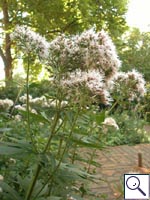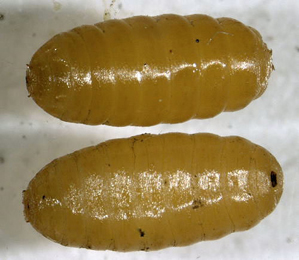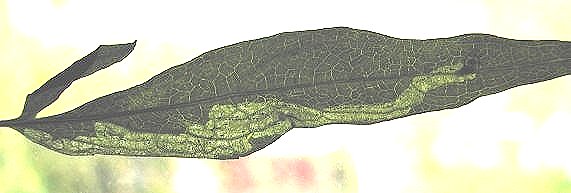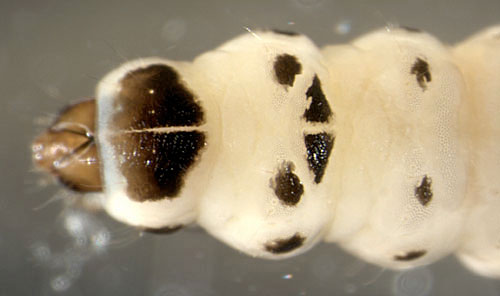|
||||||
|
EUPATORIUM. Hemp-agrimony [Asteraceae] |
|
|
Hemp-agrimony (E. cannabinum) is the only species of Eupatorium recorded in Britain. Thirteen British miners are recorded on Eupatorium. A key to the European miners recorded on Eupatorium is provided in Bladmineerders van Europa. |
 Hemp Agrimony Eupatorium cannibinum |
Key for the identification of the known mines of British |
||
Note: Diptera larvae may live in a corridor mine, a corridor-blotch mine, or a blotch mine, but never in a case, a rolled or folded leaf, a tentiform mine or sandwiched between two more or less circular leaf sections in later instars. Pupation never in a cocoon. All mining Diptera larvae are leg-less maggots without a head capsule (see examples). They never have thoracic or abdominal legs. They do not have chewing mouthparts, although they do have a characteristic cephalo-pharyngeal skeleton (see examples), usually visible internally through the body wall. The larvae lie on their sides within the mine and use their pick-like mouthparts to feed on plant tissue. In some corridor miners frass may lie in two rows on alternate sides of the mine. In order to vacate the mine the fully grown larva cuts an exit slit, which is usually semi-circular (see Liriomyza huidobrensis video). The pupa is formed within the hardened last larval skin or puparium and as a result sheaths enclosing head appendages, wings and legs are not visible externally (see examples). See Key to non-Diptera. |
||
1a > Leaf-miner: Blotch mine. |
||
1b > Leaf-miner: Corridor mine. |
||
2a > Leaf-miner: A whitish-greenish blotch. Pupation external, on the ground (Spencer, 1972b: 43, fig. 140; Spencer, 1976: 306-7, fig. 552). A chacteristically pale whitish, usually upper-surface, primary blotch. There is an initial corridor, but traces of it are almost always overrun by the later blotch. The mine is quite opaque; only by opening it can it be ascertained if the mine is still occupied. No feeding lines are apparent. Unlike other blotch mines thay may occur here, Calycomyza mines are totally flat. Pupation outside the mine. A whitish blotch mine occuring on the upper leaf surface. Starts with a short corridor and does not show feeding lines. Superficially similar to the lepidopterous mine made by Leucospilapteryx omissella, but the latter mine turns purple as it ages. |
||
|
||
Calycomyza artemisiae (Kaltenbach, 1856) [Diptera: Agromyzidae]. |
||
2b > Leaf-miner: The mine mine begins as a long, hairlike corridor. The last part of it runs perpendicular to a leaf segment. The part of the leaf that thereby is cut off wilts, and here a large blotch is made. Frass scattered in the mine. Mine practically full-depth, yellowish green to reddish brown, with conspicuous secondary feeding lines. Pupation outside the mine. See also Seidel (1926a) for an extensive description of the mine. |
||
|
||
Stemonocera cornuta (Scopoli, 1772) [Diptera: Tephritidae]. |
||
2c > Leaf-miner: The mine begins as an elongated blotch overlying a strong vein; from there broad tunnels radiate that coalesce in the end. All frass is concentrated at a central point in the floor of the mine. As a result the mine has a brownish-black centre and a paler brownish green seam. The larva often (perhaps always at daylight) rests in the centre of the mine. Primary and secondary feeding lines as a rule quite clear. Pupation outside the mine. An elongated blotch centred over a vein. There are two types: greenish with a blackish centre and entirely reddish-black. |
||
 Trypeta artemisiae pupariria Image: © Willem Ellis (Bladmineerders van Europa) |
||
|
||
Trypeta artemisiae (Fabricius, 1794) [Diptera: Tephritidae]. |
||
2d > Leaf-miner: Mine filling apex of leaf segment, with short final section extending further into leaf. Pupation normally in leaf at end of mine. Corridor, almost invariably in the ultimate cm of the tip of a leaf segment. The corridor is contorted so strongly that a compact secondary blotch is formed. When exeptionally the mine is not in the leaf tip, it is closely adjoining the leaf margin; never is a mine formed in the leaf centre. Frass irregular, in black threads and lumps, frequently at wide intervals, on alternate sides of the mine. The mine is upper-surface, except for the very last section that is lower-surface. Here pupation takes place. The puparium projects for about half of its length out of the mine. A convoluted upper side gallery that may form a secondary blotch filling apex of leaf segment. Frass in closely spaced grains that may form streaks or strings. |
||
 Mine of Liriomyza eupatoriana on Eupatorium cannabinum Image: © Rob Edmunds (British leafminers) |
||
|
||
Liriomyza eupatoriana Spencer, 1954 [Diptera: Agromyzidae]. |
||
3a > Leaf-miner: Mine primarily associated with the mid-rib. |
||
3b > Leaf-miner: Mine not primarily associated with the mid-rib. |
||
4a > Leaf-miner: A distinctive mine primarily above mid-rib, with irregular short lateral offshoots into leaf blade. Pupation external (Spencer, 1972: 51 (fig. 172), 55; Spencer, 1976: 270, 271 (fig. 486)). Branched, whitish, upper-surface corridor; main axis overlying the midrib; side branches overlying the main lateral veins. (In Campanula and Phyteuma the mine is much less branched, sometimes nothing more than a corridor on top of the midrib). Frass in rather long strings. Usually the mines begins as a long and narrow, shallow, tortuous lower-surface corridor that ends upon the midrib but otherwise is not associated with the leaf venation. Often this initial corridor is filled with callus, and then even less conspicuous. Pupation outside the mine. A linear mine on the upper surface, usually following the midrib and showing side branches along the veins. The frass is in strings. |
||
|
||
|
||
Liriomyza strigata (Meigen, 1830) [Diptera: Agromyzidae]. |
||
5a > Leaf-miner: Mine linear, whitish, both upper and lower surface. Pupation internal, at the end of the mine with the anterior spiracles projecting through the epidermis (Spencer, 1976: 433). Upper-surface, less often lower-surface corridor. Frass in isolated grains. Pupation within the mine, usually in a lower-surface puparial chamber. A long whitish upper surface corridor, which eventually goes lower surface. |
||
|
||
Chromatomyia
horticola (Goureau, 1851) [Diptera: Agromyzidae] |
||
5b > Leaf-miner: Mine long, linear, upper or lower surface, often adjoining a vein (Spencer, 1972b: 74 (fig. 244), 79). Long corridor, often following the midrib for some distance. The mine is upper- or lower-surface; often the first part lower-surface, then upper-surface. Frass in pearl chains or isolated granules. Pupation outside the mine; exit slit in the lower epidermis. |
||
|
||
Liriomyza eupatorii (Kaltenbach, 1873) [Diptera: Agromyzidae]. |
||
5c > Leaf-miner: Mine long, linear, upper or lower surface, often adjoining a vein. Puparium black |
||
|
||
Phytomyza eupatorii Hendel, 1927 [Diptera: Agromyzidae]. |
||
5d > Leaf-miner: The mine begins as a long, quite narrow corridor, usually not far from the tip of a leaf segment. Usually this corridor follows the leaf margin for some distance, but it may also run freely through the blade and may then be stongly contorted. In the end the corridor is directed towards the midrib, where an elongated blotch is formed, overlying the midrib and some of the larger lateral veins. Frass in a nearly continuous line in the initial corridor, in scattered lumps in the later part of the mine. Primary and secondary feeding lines very conspicuous when seen in transparancy. Pupation outside the mine. The mine starts as a very narrow corridor, usually close to the tip of a leaf segment and following the leaf margin. The later section of the corridor approaches the main vein, where an elongated blotch is made with long broad finger like extensions that lay over the secondary veins. In the initial corridor the frass forms an almost continuous line, in the blotch it is distributed in large scattered lumps. In fresh mines the secondary feeding lines are clearly visible. |
||
|
||
Trypeta zoe Meigen, 1826 [Diptera: Tephritidae]. |
||
|
Key for the identification of the known mines of British |
Note: The larvae of mining Coleoptera, Hymenoptera and Lepidoptera may live in a corridor mine, a corridor-blotch mine, a blotch mine, a case, a rolled or folded leaf, a tentiform mine or sandwiched between two more or less circular leaf sections in later instars. Larva may pupate in a silk cocoon. The larva may have six legs (although they may be reduced or absent), a head capsule and chewing mouthparts with opposable mandibles (see video of a gracillarid larva feeding). Larvae of Hymenoptera and Lepidoptera usually also have abdominal legs (see examples). Frass, if present, never in two rows. Unless feeding externally from within a case the larva usually vacates the mine by chewing an exit hole. Pupa with visible head appendages, wings and legs which lie in sheaths (see examples). |
1a > Leaf-miner and case-bearer: The larva lives outside the mine, protected by a case, and feeds on the underlying plant tissues via a hole cut in the epidermis. From that point it eats away as much leaf tissue as it can reach without fully entering the mine. Mine does not contain frass (Coleophora species) |
1b > Leaf-miner, but not a case-bearer: The larva lives mainly inside the mine. Mine usually contains frass. In later instars the larva may live sandwiched between two more or less circular sections cut from the leaf. |
2a > Leaf-miner and case-bearer: The larva makes at least two cases and leaves the empty case by the cut out leaf section. The early cases are compressed with keels, dorsally and laterally. Later cases are more tubular and hairy (from the hairy leaves, used to make the case). Larva in a spathulate leaf case. It is 10-12 mm long, straght, brown, tubular, patently hairy (depending on the hostplant), bivalved. The mouth angle is rather variable, usually around 45°. An unusual character of this species is that after each moult the larva makes a new case; the old, vacated case is left at the place where the new one is made, at the leaf margin. |
|
Coleophora conyzae Zeller, 1868 [Lepidoptera: Coleophoridae]. |
| 2b > Leaf-miner and case-bearer: Larva mines leaves. On Eupatorium the case is extended at the anal end by adding silk and widened by cutting a ventral gusset. On Inula the case is firstly extended by adding rings of leaf-cuticle at the oral end, before reverting to the method used when on Eupatorium. The full-grown case is 10 mm long. A slender tubular silken case, about 10 mm long, straw coloured, three valved. Mouth angle about 30°. |
 Coleophora folicularis larva, dorsal Image: © Willem Ellis (Bladmineerders van Europa) |
|
Coleophora follicularis (Vallot, 1802) [Lepidoptera: Coleophoridae]. |
2c > Leaf-miner and case-bearer: The larva builds a 'pistol case'. The mature case is around 15mm long with a slightly swollen middle region, being palest at the anal end. Larva in a slender tubular silken case. The case is about 15 mm long, yellow-grey, and trivalved. The mouth angle is about 0°-10°, causing the case to lie flat on the leaf. |
|
Coleophora inulae Wocke, 1877 [Lepidoptera: Coleophoridae]. |
3a > Leaf-miner: The larva mines the leaves, forming brownish or whitish inflated blotches. Whitish or brownish full depth blotch, preceded by a short corridor that originates on the midrib or in the leaf base. Frass grains irregularly dispersed; part of the frass is ejected from the mine. The larva makes several mines. Pupation outside the mine. |
|
| Digitivalva pulicariae (Klimesch, 1956) [Lepidoptera: Acrolepiidae]. |
| Last updated 09-Jul-2020 Brian Pitkin | ||

